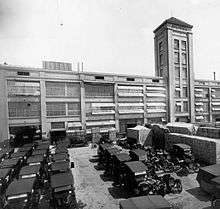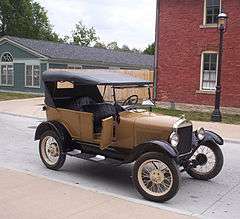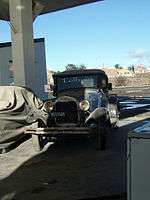Ford Motor Argentina
 | |
| Subsidiary | |
| Industry | Automotive |
| Founded | 1913 |
| Founder | Henry Ford |
| Headquarters | General Pacheco, Buenos Aires. Argentina |
Key people | Jorge Di Nucci (Manager Institutional Affairs) |
| Products | currently: Ford Focus, Ford Ranger |
Number of employees | 2,123 |
| Website | www.ford.com.ar |
Ford Motor Argentina is a subsidiary of Ford Motor Company and was founded in Buenos Aires in 1913.[1] Its first products were Model Ts assembled from complete knock down (CKD) kits provided by Ford Motor Company in 1917. Nevertheless, Ford Motor Argentina is best known in more recent times for producing the Ford Focus and, previously, the Argentine version of the Ford Falcon,[2] originally a US model introduced in Argentina in 1961, but adapted to the Argentine market.
History

In 1913, Ford entered the Argentine market, and in 1917, Buenos Aires became home to the first assembly operation of Ford products in Latin America, in 1922 a stamping and assembly factory was inaugurated in La Boca. At that time the products were marketed through a net composed of 285 dealers. The administrative staff and the personnel of paid workers came to 400. Later, and due to the rising demand the plant was enlarged, coming its staff to 1,500 people.


In 1939, with the Second World War outbreak, the importation of vehicles and components is closed. The production was restricted to finishing the units with the available material, but the increasing lack of basic supplies for the production forced to stop the activity. During this time, Ford manufactured batteries and it attended its clients with the sale of spare parts and car accessories made in local repair shops. Later, this would give rise to the beginning of the Argentinean auto part industry.
In 1957 Ford Motor Argentina activities restarted in its La Boca facilities with the first commercial vehicles of the "F" line pick ups produced. This manufacturing plant originally opened in 1925 for the production of the Ford Model T. In 1962 the "F" line pick ups began to be produced at the Pacheco Assembly Plant. The former Ford Motor Argentina S.A. was incorporated in 1959.
Autolatina joint venture
In 1987, Autolatina Argentina was formed by the merger of Ford Motor Argentina and Volkswagen Argentina. Each brand maintained their own corporate image, the marketing and sales structures, as well as independent dealerships and service shops. All other departments were consolidated, allowing significant cost cutting, but also cutting the workforce almost in half. Sales figures and profitability were disappointing and the joint venture was dissolved in 1994, and on 1 January 1995, Ford Argentina S.A. was reestablished. Under the Autolatina separation plans, Ford became sole owner of the Pacheco plant, which was modified to incorporate the production of the Escort car and Ranger pick-ups. (Volkswagen acquired the existing truck plant and converted it for car assembly.)
In December 1996, all Ford Argentina plants and the Customer Assistance Division obtained ISO 9002 certification and in April 1999, Pacheco Assembly Plant obtained ISO 14001 certification.
In August 2000 the production of the Ford Focus started in Pacheco Plant, and the Focus was honored as the "Car of the Year" in Argentina by two different councils of journalists.
In 2000, Ford held 14.9% of the market share, ranking second in the market. Market participation was 13.4% in cars and 18.9% in trucks; where Ford maintains leadership, production volume was 56.300 units. Ford ranked first among automotive manufacturers regarding exports. In 2007, Ford has 12.8% market share, ranking third after Peugeot-Citroën [PCA] (28.5%) and General Motors (20.5%) with a production volume of over 64.000 units.[3]
With over 95 years of industrial presence in Argentina, Ford is a highly appreciated brand in Argentina, with a very positive image. Ford was elected as the brand of the century. Its production facilities are dedicated to supply products for the domestic market and to exports to several countries. A large portion of its production is exported, making Ford among the export leaders in the country.
General Corporate Timeline
- 1913: Ford entered the Argentine market, first Latin-Americans branch and the second one in the world after United Kingdom.
- 1917: The importation of dismantled cars to be assembled in Buenos Aires begins.
- 1925: The first Latin-American Ford plant is inaugurated with the production of the model "T".
- 1927: 100,000 Model T's produced in La Boca plant.
- 1928: The "A" model, is launched.
- 1932: Ford V8 is launched and assembled until 1942
- 1945-1947: Ford began assembly after the war.
- 1957: F-Series Pickup Truck assembled in La Boca plant.
- 1961: F-600 truck and B-600 bus chassis are produced.
- 1961: Production of the Ford Falcon began at the Boca site.
- 1962: Pacheco Assembly and Stamping Plant are started.
- 1962-1991: Falcon manufactured and sold in Argentina.
- 1962: F-Series Truck manufactured in Pacheco plant.
- 1965: Henry Ford Technical School established.
- 1967: Ford purchased Metcon Foundry and Transax Transmission plants.
- 1969-1981: Ford Fairlane manufactured and sold in Argentina.
- 1974: Ford Taunus is launched.
- 1977-1984: Ford attained market leadership in total vehicles, peaked at 38% in 1982.
- 1979: Ford Falcon becomes Argentina's top selling car with 28,522 units sold, accomplishment repeated six times.
- 1982: Truck Assembly plant inaugurated.
- 1982: 1,000,000 units delivered with Ford Taunus / Ford leads with a 38% market penetration.
- 1984: Ford Sierra is launched.
- 1987: Ford and Volkswagen formed Autolatina Joint Venture. / Ford Escort is launched.
- 1991: Ford Falcon ends production after a record 30-year run, 490,000+ produced.
- 1994-1995: All Ford Argentina facilities achieve Q1.
- 1994: Ford Orion is launched.
- 1975-1995: Ford has been market leader in trucks for 20 consecutive years.
- 1995: Autolatina Joint Venture dissolved. / Truck Plant and Transax transferred to Volkswagen.
- 1996: Ford Argentina S.A. reestablished. / ISO9002 certification achieved. / Ford Ranger production started.
- 1997: Ford elected "The Brand of the Century" in Argentina. / Ford leads in exports.
- 1998: 2,000,000 units delivered.
- 1999: Ford Argentina facilities achieved ISO 14001.
- 2000: Focus local production started. / Focus elected "The car of the Year" in Argentina. / Ford began selling Mazda products in Argentina as a separate brand.
- 2001: Ford starts to sell Volvo and Land Rover products in Argentina as separate brands.
- 2007: Ford invests US$156.5m in Pacheco facility[4]
- 2010: Ford Focus 2, Ford Sigma, Ford Kuga and new Ford Ecosport y Fiesta are launched.
Models assembled/manufactured/marketed (in chronological order)
Passenger cars
- Ford Model T assembled (1917–1925)
- Ford Model T manufactured (1925–1928)
- Ford Model A (1928–1932)
- Ford V8 (1932–1942)
- Ford Falcon (1962–1991)
- Ford Fairlane (1969–1981)
- Ford Taunus (1974–1983)
- Ford Laser (1981–1983)
- Ford Sierra (1984–1993)
- Ford Escort (1987–2002)
- Ford Orion (1994–1997)
- Ford Galaxy (1992–1996)
Current passenger cars in production
- Ford Focus (1999–present)
Trucks
- Ford F-250 Chassis
- Ford F-350 Chassis
- Ford F-400 Chassis
- Ford F-500 Chassis
- Ford F-600 Chassis (1959-????)
- Ford B-600 Chassis (1959-????)
- Ford F-700 Chassis
- Ford F-6000 Chassis
- Ford F-7000 Chassis
- Ford F-100 / F-150 Pick-up (1957–1997)
- Ford F-150 / F-250 Pick-up (2x4 / 4x4) (1980–1997)
- Ford Cargo 1722 (1998–2000)
Current trucks in production
- Ford Ranger (2x4 / 4x4) (1996–present)
Current Models
(As of April 2013)
Current passenger cars
- Ford Ka
- Ford Fiesta One (5th gen Hatchback)
- Ford Fiesta Max One (5th gen Sedan)
- Ford Kinetic (6th gen Hatchback)
- Ford Kinetic 4P (6th gen Sedan)
- Ford Focus (Both Hatchback and Sedan versions)
- Ford Mondeo
- Ford S-Max
- Ford Nueva EcoSport
- Ford Kuga
Current commercial vehicles
Ford in South America
In South America, Ford's primary operations are in Brazil, Argentina and Ford Andina[5] (Venezuela, Colombia and Ecuador). Ford employs over 18,000 people and operates seven assembly or other plants in the region.[6]
See also
References
- ↑ www.auto-historia.com History of Ford in Argentina - accessed 29 November 2008
- ↑ www.todofalcon.com.ar Historia del Ford Falcon (In Spanish) - accessed 29 November 2008
- ↑ www.buyusa.gov Archived 3 November 2008 at the Wayback Machine. - accessed 7 December 2008
- ↑ www.automotiveworld.com Ford to invest US$156.5m in Pacheco facility - accessed 30 December 2008
- ↑ Ford Automotive Operations - Latin America - Accessed 03/11/2011
- ↑ www.ford.com Archived 24 April 2008 at the Wayback Machine. Ford Motor Company Global Operations - accessed 1 December 2008
External links
| Wikimedia Commons has media related to Ford Motor Company of Argentina. |